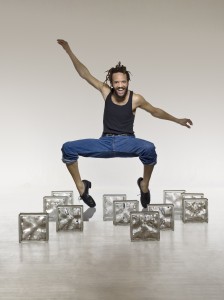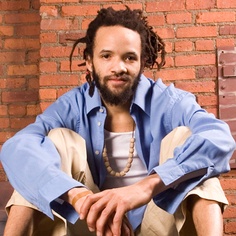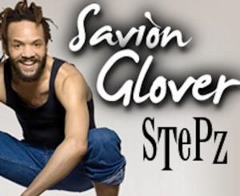THE MAN BEHIND THE STEPZ
As part of an international tour, Savion Glover’s newest work STePz arrives at the Valley Performing Arts Center in Northridge this Friday, March 7. This two-act entertainment, which consists of several individual tap numbers, features Glover and four other dancers: Robyn Watson, Ayodele Casel, Sarah Savelli (a.k.a. the 3CW, or 3 Controversial Women), and Marshall Davis Jr. In the short time Stage and Cinema talked with the artist, not much was revealed about his upcoming show. Perhaps it is his way of increasing the anticipation, but based on his 2012 sold-out appearance at VPAC, there is every indication that Glover will not disappoint.
Savion Glover is easily one of the best tap dancers this country has ever produced; he is both an institution and the reigning rock star of the tap. Ever since the wunderkind tap dancer made his Broadway debut at the age of 12 in The Tap Dance Kid, this indefatigable 40-year-old has come to define tap for a modern generation. Known especially for his Tony-winning choreography of Bring in ‘da Noise, Bring in  ‘da Funk (1995), which ran on the Great White Way for 1135 performances, this hoofer came into being during the age of Stomp, a world-wide phenomenon that thrilled audiences with nothing more than the pounding clickety-clack of young athletic rhythmists using everyday objects.
‘da Funk (1995), which ran on the Great White Way for 1135 performances, this hoofer came into being during the age of Stomp, a world-wide phenomenon that thrilled audiences with nothing more than the pounding clickety-clack of young athletic rhythmists using everyday objects.
While many still hold tap as the Nicholas Brothers, Broadway-style buck and wing, the ballroom tap of Fred Astaire, or Gene Kelly’s balletic hoofing on rain-drenched cobblestone, Glover sees a direct connection between tap and the African-American experience which gave rise to this distinctly American art form. During the early slave trade, slaveholders banned the use of native African instruments, fearing this form of communication would lead to revolt, but slaves were allowed to dance. Tap, as we know it today, evolved during the lampooning Minstrel Shows of the mid-1800s as well as the classier Vaudeville duets, which in turn gave birth to the jazzier style of tap we see today, perfected by luminaries such as Glover’s mentors Gregory Hines, Jimmy Slyde, and Henry Le Tang.
 As a teacher and choreographer, he is ensuring the longevity of the art form. The man who choreographed the animated movie Happy Feet founded HooFeRzCLuB, a tap dance school located in his birthplace of Newark, New Jersey.
As a teacher and choreographer, he is ensuring the longevity of the art form. The man who choreographed the animated movie Happy Feet founded HooFeRzCLuB, a tap dance school located in his birthplace of Newark, New Jersey.
His dance style displays an uncanny ability to combine movement, rhythm, and sound with unparalleled virtuosity. He captures the traditional form, sounds, and steps created by the original tap hoofers (he continually praises his mentors, teachers, and past tap greats), and helps the audience to see the steps anew by embellishing rhythm, speed, and showmanship. He identifies himself as a disciple of tap dance, not its savior. As Glover puts it, he is a Saint Jimmy Slyde of tap.
STAGE AND CINEMA: How did you start dancing? What specifically drew you towards the tap dance genre?
SAVION GLOVER: My mom took me to a tap class when I was young but my love—or my passion for tap rather—didn’t form until much later. It really wasn’t until I started to learn under the great men and women of tap dance that my love for it began to exist. I then went on to take ballet and jazz, but tap was always my favorite. It was my calling.
S&C: What is your teaching philosophy and approach to the art?
SG: Well, I allow my students to express what they want to say through dance. I don’t like to teach steps. I teach dance education. I want them to know everything they can about the history of tap, like its roots and where it comes from. I teach about the great men and women responsible for my placement—those who play a vital part in the learning process—because I would not exist without them. Dance is about history and connection just as much as it is about learning how to do the steps.
S&C: What is your choreographic process like?
SG: In essence it varies. The point is to choreograph for the show, whatever that may be, because it always changes. For example, is there music? Is there no music? It is my job to interpret the sound by hearing it a new way or creating it myself. Sometimes the choreography is trying to hear the music through the dance (the movement and tapping) without the instruments. I deliver a message through the dancing. Despite how the process or my approach changes, I have to communicate through the steps.
S&C: What do you want your audience to see in STePz? Is there a story?
SG: It is a concert. There is a concept within each number. There is a story in each number. I hope that the audience will be able to relate to each of the stories or see what is happening.
S&C: Do you have any words of wisdom for dancers today?
SG: (Chuckles) YEAH: GOOD LUCK!
photos by Lois Greenfield
STePz
Savion Glover featuring Marshall Davis, Jr. & 3CW
Valley Performing Arts Center in Northridge
Friday March 7, 2014 at 8 pm
for tickets, call (818) 677-3000 or visit www.valleyperformingartscenter.org
for more info on Savion Glover visit Savion Glover Productions or HooFeRzCLuB
for tour info, visit CAMI Music


